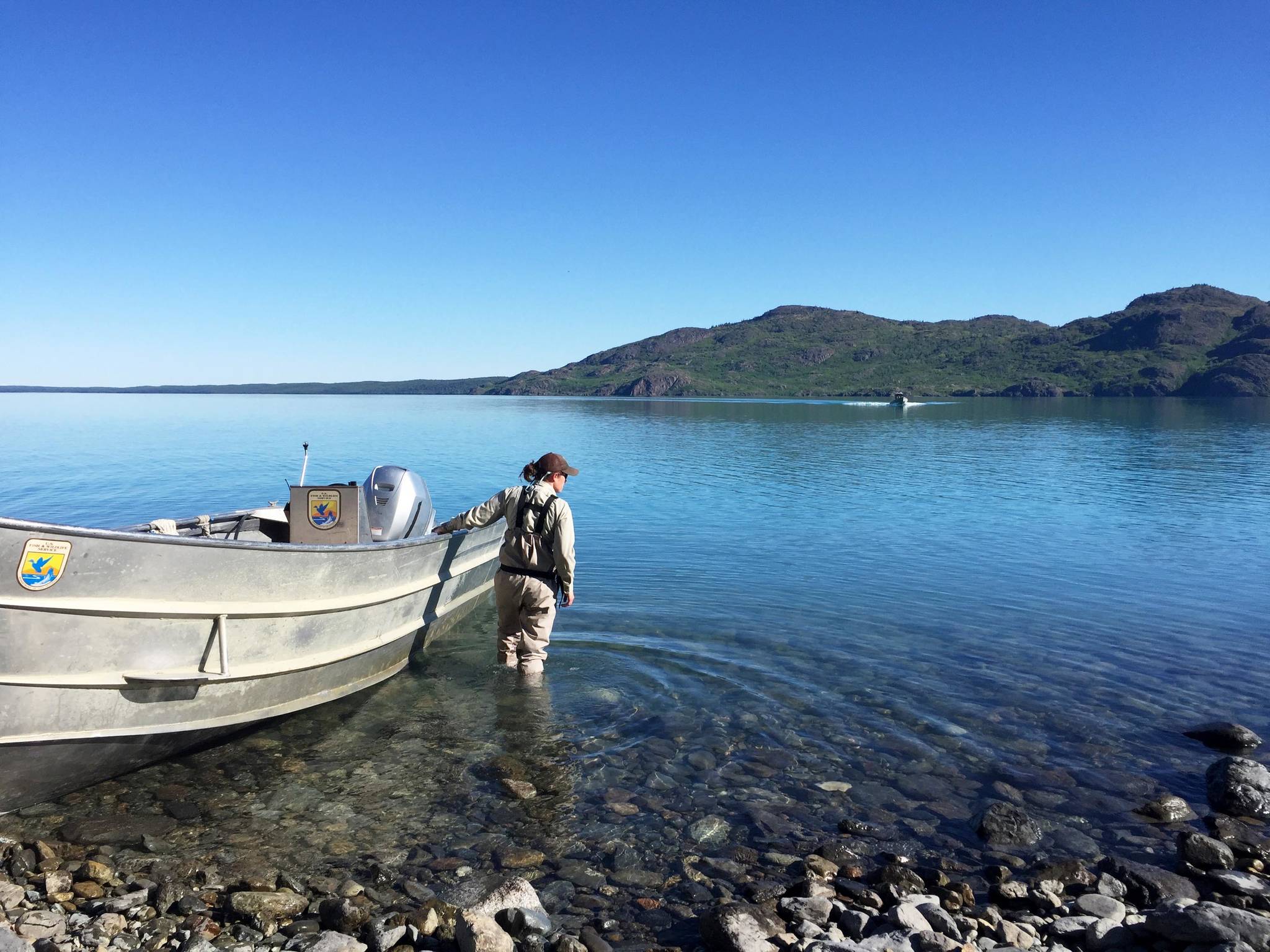The trails crew leaders call part of the Cottonwood Creek Trail “the Enchanted Forest.” I could immediately see why.
As soon as I climbed the ridge into the bench land, the scrubby black spruce forest thinned out into majestic hemlocks with a forest floor coated in verdant moss and lowbush cranberry. Sunlight filtered down through the canopy to dapple the ground, and the light sound of the creek in the gorge sprinkled musical notes through the silence.
But trees will fall, even in the Enchanted Forest. And this year, there were a lot of them. Along about a mile-and-a-half-long section of the Cottonwood Creek Trail, the volunteer crew I was with on Saturday hacked, sawed and lugged about six massive trees off the wilderness trail with hand tools. The Friends of the Kenai National Wildlife Refuge, a citizen group supporting the peninsula’s refuge, organized the cleanup day as an opportunity to help the refuge staff and to celebrate National Trails Day.
I, a motor boat-deprived soul, had never been to the south shore of Skilak Lake before. Luckily for our heads and our stomachs, the lake was flatter than I’ve ever seen it, with the boats skimming lightly across the glassy surface. All told, 11 volunteers and two refuge staff members piled out of the boats, strapped ourselves with handsaws and loppers and set off into the woods for the day.
I had hiked into much of the road-accessible wilderness I could reach on foot, but this was my first time in proper Kenai National Wildlife Refuge wilderness area. Other than the Skilak Lake Recreation Area, which follows the loop road connected to the Sterling Highway, most of the refuge’s trails traverse remote backcountry.
The Cottonwood Creek Trail snakes up alongside its namesake creek and into the alpine territory, overlooking much of the land between Skilak and Tustumena lakes. It’s relatively well used, with clear a trail route even when it’s buried in leaves. There’s a wilderness lodge with its own access to the trail and it’s only a 20-minute boat ride from the Upper Skilak Lake Campground boat launch.
The 11 of us signed up for the volunteer day in pairs or groups of three or four, showing up with backpacks and work gloves as strangers. As we hiked and clipped trees, we chatted, starting with that standard Alaska question: “Where are you from? So how did you wind up here?”
The trail workers in all the wilderness parts of the refuge aren’t allowed to use motor tools — it’s part of the refuge’s rules — so all the work was by blade and sweat. The first hour went relatively smoothly until our first major obstacle appeared — a fallen spruce tree and birch tree, twined together, obstructing the path on a sharp uphill. A small handsaw wasn’t good enough, and neither was the longer Katana saw. No, it was a job for the crosscut saw, an incredibly useful lumberjack-style, two-man tool with teeth the length of one of my fingers.
Laughter and encouragement erupted as a volunteer and a refuge trails staffer lunged back and forth, attempting to get through the thick spruce trunk. With gusto, three other volunteers fell upon a victim with a narrower trunk, tugging and sawing to clear the narrow trail.
The saw broke through with a satisfying crack. The two lumberjacks fell back into the brush and the woods echoed as the crew let out a “Whoop!” Branches cracked and the heavy trunk fell. One more cut through the rings of the aged tree, and we lugged it into the woods to nourish the forest of the future. The trail clear, we pressed on.
The higher we climbed, the better we worked together. Safety planning was a major consideration — how best to cut a tree without it falling on you or another crew member? We rolled, sliced, twisted and pulled fallen trunks away from the trail, with only minor scratches and a few close calls. By the time we rose to the tree line, we each knew most of the others’ names.
By the time we turned around to head for the shoreline again, most of the group was easily chatting, comfortable shouldering the tools we now knew how to use. Passing through the twig-scattered trail where we’d sweated to remove a tree left a distinct feeling of satisfaction. I took a deep breath as we passed back through the Enchanted Forest on our way down, already planning another time to return to its arbors.
Avid hikers like myself regularly tick off trails and peaks from our list so we can brag to our friends that we’ve put our feet on a lot of beautiful backcountry. But one thing I learned Saturday was just how much of the Kenai National Wildlife Refuge is still new to me. I’ve never visited any of the remote trails crisscrossing the refuge at the head of Tustumena Lake, nor even the canoe trail system north of Sterling.
The National Park System has been called the nation’s best idea, but it goes beyond just the parks. With my legs under me and an inReach satellite device just in case, I can go anywhere my strength will take me (being careful not to destroy habitat as I go, of course). The whispers of earlier adventurers linger in the tangled branches, saying, “Carry on, carry on, a little farther now.”
The trails traversing the Kenai National Wildlife Refuge provide an entry point to that wilderness. Gaze out across the flats and ridges of the refuge and release the pressure of your weekly routine. Time vanishes in those eternal landscapes. Freedom rises instead, carrying us along.
Happy National Trails Day. Go find one you haven’t done yet.
Reach Clarion reporter Elizabeth Earl at eearl@peninsulaclarion.com.

